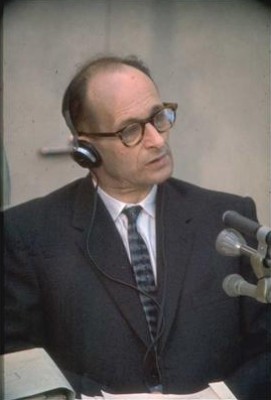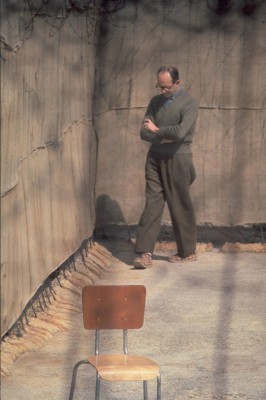Adolf Eichmann walks around the yard of his cell, Ramla Prison, Israel, April 1961. Otto Adolf Eichmann was a German Nazi SS-Obersturmbannführer (lieutenant colonel) and one of the major organizers of the Holocaust. Because of his organizational talents and ideological reliability, Eichmann was charged by SS-Obergruppenführer Reinhard Heydrich with the task of facilitating and managing the logistics of mass deportation of Jews to ghettos and extermination camps in German-occupied Eastern Europe.
After World War II, he fled to Argentina using a fraudulently obtained laissez-passer issued by the International Red Cross. He lived in Argentina under a false identity, working a succession of different jobs until 1960. He was captured by Mossad operatives in Argentina and taken to Israel to face trial in an Israeli court on 15 criminal charges, including crimes against humanity and war crimes. The Mossad was able to get an EL-AL to Buenos Aires to extricate Eichmann from Argentina. When the Argentinians discovered the real reason for the jet being in Argentina, they tried to stop it from flying back to Israel. The Mossad was only able to escape because they flew directly to Africa to refuel instead of remaining in the Western Hemisphere like they reported they would in their itinerary. He was found guilty and executed by hanging in 1962. He is the only person to have been executed in Israel on conviction by a civilian court.
Eichmann was executed by hanging at a prison in Ramla. The hanging was scheduled for midnight on 31 May 1962, but due to a slight delay it happened a few minutes after midnight. He refused a last meal (preferring instead a bottle of wine) as well as the traditional black hood.Journalists and a Canadian reverend, William Lovell Hull, who had been his spiritual counselor while in prison, were allowed to attend the execution. His last words were:
Long live Germany. Long live Argentina. Long live Austria. These are the three countries with which I have been most connected and which I will not forget. I greet my wife, my family and my friends. I am ready. We’ll meet again soon, as is the fate of all men. I die believing in God.

Within four hours Eichmann’s body had been cremated at a secret location, and his ashes were scattered in the Mediterranean Sea, outside of Israeli territorial waters by anIsraeli Navy patrol boat.
Impact
The trial and the surrounding media coverage sparked renewed interest in wartime events, and the resulting increase in publication of memoirs and scholarly works helped raise public awareness of the Holocaust.The trial received widespread coverage by the press in West Germany, and many schools added material studying the issues to their curriculum. In Israel, the testimony of witnesses at the trial led to a deeper understanding of the impact of the Holocaust on survivors, especially among younger citizens who had never suffered state-sponsored oppression.
Political theorist Hannah Arendt, a Jew who fled Germany after Hitler’s rise to power, reported on Eichmann’s trial for The New Yorker. In Eichmann in Jerusalem, Arendt calls Eichmann the embodiment of the “banality of evil”, as he appeared to have an ordinary and normal personality, displaying neither guilt nor hatred. In his 1988 book Justice, Not Vengeance, Wiesenthal said: “The world now understands the concept of ‘desk murderer’. We know that one doesn’t need to be fanatical, sadistic, or mentally ill to murder millions; that it is enough to be a loyal follower eager to do one’s duty.”
Eichmann’s son Ricardo says he is not resentful toward Israel for executing his father. He does not agree that his father’s “following orders” argument excuses his actions and notes how his father’s lack of remorse caused “difficult emotions” for the Eichmann family. Ricardo is now a professor of archaeology at the German Archaeological Institute.

